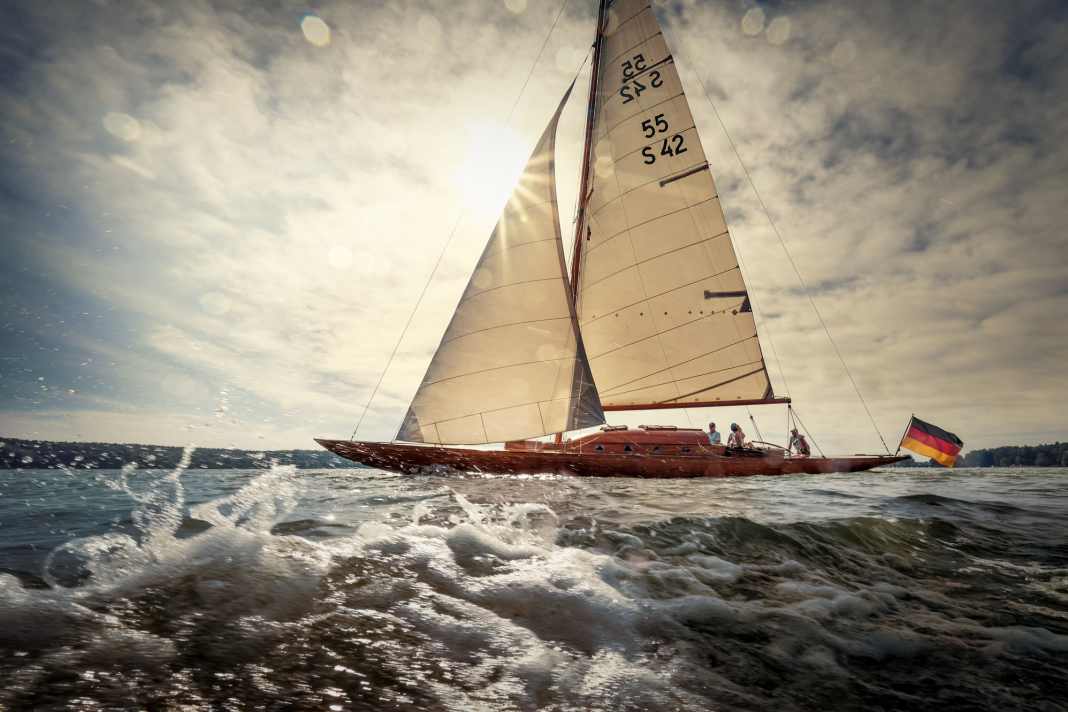





- The "Master of Lines", Erik Salander, designed the archipelago cruiser
- After crossing the Atlantic, we had to get our own boat
- Great atmosphere and great friendships on board "La Liberté"
- Careful restoration after the first season
- First owner Max Gumpel sailed "La Liberté" with his girlfriend Greta Garbo
- Boxes of original equipment were included
- Technical data "La Liberté"
"Have you ever seen such a beautiful cleat?" Rebecca Tschöpe points to the foredeck, beaming. She gives a tour of her new boat and can't stop raving about it. She pulls old wooden blocks out of a drawer in the cockpit. "Still original too. Great, isn't it?" Last year, the 52-year-old and her husband Carsten bought the 55-metre skerry cruiser "La Liberté" from Sweden. A boat that has so much more to offer besides the many details: glamorous previous owners, great friendships, fascinating stories and rumours.
Swedish Prince Carl Bernadotte, for example, personally wrote a song about the ship. As a good friend of the first owner Max Gumpel, he was a frequent guest on board. While the song was being premiered, the Second World War was raging in Europe. But the famous Swedish actor and singer Karl Gerhard still sang merrily for the crew of the "La Liberté". Their anthem pokes fun at the warring parties in a cabaret style, but also sings about the boat itself and its crew.
"With 'La Liberté', Max has created a fairytale ship with the highest degree of modernity," it says. "Yes, a ship that works at the touch of a button. That must be the most beautiful thing there is." Max, that was Max Gumpel, Swedish Olympian and industrialist, who had once commissioned "La Liberté".
The "Master of Lines", Erik Salander, designed the archipelago cruiser
The skerry cruiser was designed by Erik Salander, the "master of lines". Anyone familiar with these boats will recognise their origins from the sweeping lines typical of Salander. "Libban", as she is affectionately known in Sweden, was completed in 1934 at Oscar Schelin's shipyard in Kungsör near Stockholm.
The ship was so heavy that it could not be officially measured as a skerry cruiser
But what was launched there was, as the song suggests, not just a new skerry cruiser. It was an example of the technical development of the time, because Gumpel had not skimped on modern equipment. He not only had "La Liberté" equipped with electric winches and a diesel engine, but also with hot water heating, a gramophone, a porcelain toilet and a refrigerator. However, there was one disadvantage: the ship was so heavy that it could not be officially measured as a skerry cruiser. But that didn't bother Gumpel, he just wanted to go on cruises with "La Liberté".
Good luck to the new owners
That, in turn, is difficult on the Wannsee, where you can't sail really long distances. Nevertheless, the Tschöpe couple are happy in the cockpit, she on the tiller, he on the jib sheet. That's how it usually is. "I steer the boat, Carsten steers the family," jokes the helmswoman. The routine and calmness with which she steers the "La Liberté" is testament to Tschöpe's experience. Together with her father, she has been sailing since she was 14 years old, gaining all her sailing licences up to and including her ocean racing licence. From then on, the family spent their holidays on charter yachts. Now that she is allowed to steer her own ship, she clearly enjoys it. She guides the crew through sometimes complex manoeuvres with a great deal of calm and confidence.
Husband Carsten also has a family history of nautical expertise. His great-grandfather Maximilian Schuler was once involved in the development of the gyrocompass in Kiel. "History is important to me," he says. "That's why I was immediately taken with the 'La Liberté'."
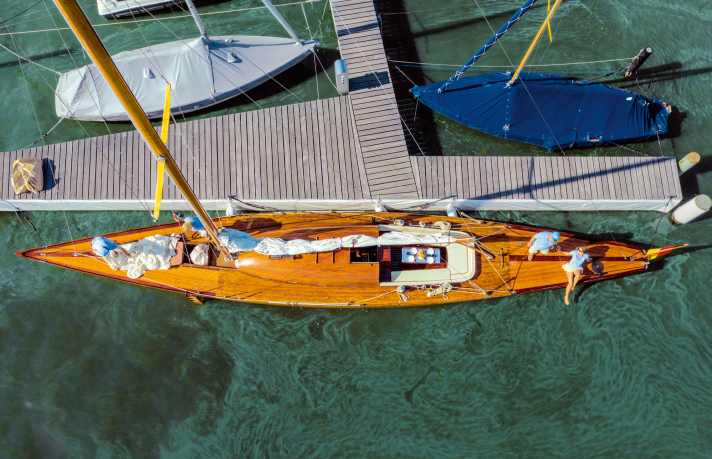
With her 16 metre high mast, she towers above most of the other boats on Wannsee, but on this weekday in late summer, she is alone on the otherwise busy lake. The sun has come out and is joined by a light wind that pushes the old yacht along.
Rebecca Tschöpe's old sailing friend Christoph Schmidt is also on board. They have shared a passion for classic boats since their school days, when they spent summers on wooden boats with the scouts, which they restored in winter. He was immediately enthusiastic when Rebecca told him about the purchase, says Schmidt. "Because I knew that Rebecca knew what she was getting into."
After crossing the Atlantic, we had to get our own boat
In fact, she had already realised it when she found a rotten spot on the stern during her first visit to the "La Liberté" in Sweden in 2022. But she had fallen in love with this ship and so had her husband Carsten, so they had to have it, that was clear. Because "La Liberté" had reappeared like a crush that had disappeared from the scene. "We had originally discovered it online three years earlier," says Tschöpe. At the weekend, the two doctors would have liked to browse the marketplace of the Friends of Classic Yachts with a coffee in bed. "We immediately liked the design of 'La Liberté'," adds Carsten Tschöpe.
They contacted the owners' association and made an appointment for a viewing via Zoom. "That day, we were sitting in front of our computer screen with excitement when we got a call. The owner wasn't feeling well at all, he was having difficulty breathing." It was the beginning of 2020 and the previous owner, Mikael Beving, had contracted the coronavirus. Lockdowns followed, and the Tschöpes were challenged in their management positions as doctors in the hospital.
In 2022, Rebecca Tschöpe fulfilled her long-cherished dream of crossing the Atlantic. "And then," says Carsten Tschöpe, "she came back and said: 'I need a boat now'." She asked what had happened to the "La Liberté". The owner never got in touch again, they weren't even sure if he was still alive after his illness. But Rebecca wanted to know: "I'll call him now."
Great atmosphere and great friendships on board "La Liberté"
With success: they were lucky, said Mikael Beving on the phone, the ship was still for sale. And so Carsten and Rebecca Tschöpe travelled to Sweden to see the ship and meet the previous owners. "The most important thing for us was to find passionate buyers who valued the ship," explains Mikael Beving today, who was also contacted by other interested parties. Including even the owners of the shipyard. But there was always a snag somewhere. It was only in the Tschöpe couple that he finally found the new owners.
Good humour on board and great friendships are deeply rooted in the history of "La Liberté". There was Gumpel's best friend Eric Erickson, for example, who is regarded as the most important American spy during the Second World War. He helped the Americans to scout out German oil refineries. He is said to have repeatedly discussed his plans with Gumpel on board the "La Liberté". But Gumpel and Erickson had something else in common: they were both of Jewish descent and therefore had to be particularly careful at the time.
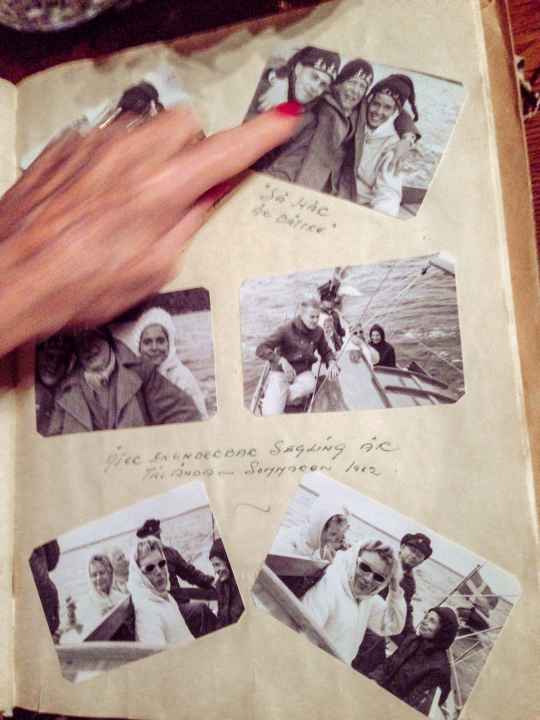
In the meantime, a good friendship had developed between the Tschöpes and "La Libertés" previous owners, and so the skerry cruiser was finally transported to Berlin by a haulage company in April 2022. "I wanted to get on the water straight away," says Rebecca Tschöpe. "We hadn't even sailed her yet!"
The Tschöpe family had already found a berth for the 16.30 metre yacht at the Seglerhaus am Wannsee (VSaW) association. Since then, "La Liberté" has been moored there at the head of a jetty. A beautiful spot, but the mooring and casting off manoeuvres were difficult at first, so a motor was needed. Rebecca Tschöpe proudly describes the idea of installing an electric motor as "tradition meets modernity". Because the predecessor, a heavy outboard motor, was not an option.
Careful restoration after the first season
Despite necessary maintenance measures, "La Liberté" spent her first Berlin summer in the water. The new owner family got to know her, went to classic regattas and moved the wooden beauty around as often as possible.
In December 2022, the first restoration work began at Bootsbau Welkisch. The reason for the rotten spot at the stern was quickly found: The pulley attached below deck to the backstay was completely rusted and the rust had attacked the wood, causing water to run through the deck from above.
"That's when I said: 'We'll do the procedure minimally invasively, please'," says Rebecca Tschöpe. Welkisch jokingly asked if she could lend him a couple of endoscopes from the clinic for the repair, but the wooden boat builders naturally knew what to do. They carefully removed individual planks from the hull below the transom and the fish on the aft deck and replaced the pulley. The rotten wood was replaced and the aft deck and foredeck were sanded and repainted.
But it wasn't just the shipyard that went to great lengths to ensure that the slender beauty was fit for many more hours of sailing on the Wannsee. Because the insurance company refused to insure the old rig, the Tschöpe family looked for someone who could renew the standing rigging. In Andreas Haubold, at whose shipyard the electric motor was also installed, they found an expert who became a friend over time. "Old parts like that connect somehow," says Haubold, who wanted to help keep as much as possible in its original condition and replaced the wires of the standing rigging with Dyneema so that it would fit through the small blocks in the mast.
First owner Max Gumpel sailed "La Liberté" with his girlfriend Greta Garbo
It now stands proudly in its place again. In the middle of the Wannsee, with its dress of white sails. As if to say: "Look where I've landed. How far we've come!" Carsten Tschöpe likes to reflect on the significance of this place for "La Liberté". "You have to realise that," he says in a calm, thoughtful voice. "Back there is the House of the Wannsee Conference. Gumpel, Erickson and their friends risked their lives for what was negotiated there. And now 'La Liberté' sails here with the German flag, in this historic place in free Germany. My God, how beautiful," he says and smiles. When they talk about their ship, the Tschöpes always have such profound thoughts. And they make a happy picture, the lively Rebecca and the philosophical Carsten, who seem so content with themselves and their "La Liberté".
It was the happiest time of my life"
According to the stories, they were not the first happy couple on the archipelago cruiser, as Max Gumpel often sailed her with his first love, the actress Greta Garbo. The two were a couple even before Garbo went to Hollywood and remained close friends for the rest of their lives. Gumpel also met his future wife Carina on board. She is still alive, looks back fondly on the hours spent on board and says: "It was the happiest time of my life."
The new owners lend a hand with the restoration themselves
To get the "La Liberté" afloat for next summer, the crew as well as the Welkisch and Haubold shipyards were kept busy last winter. Rebecca Tschöpe's long-time friend Christoph Schmidt carried out quite a few of the smaller restoration jobs in his workshop. For example, he took apart all the old blocks, cleaned the shafts and replaced bolts where necessary. After a lot of woodwork, at least eight coats of varnish were applied to each block.
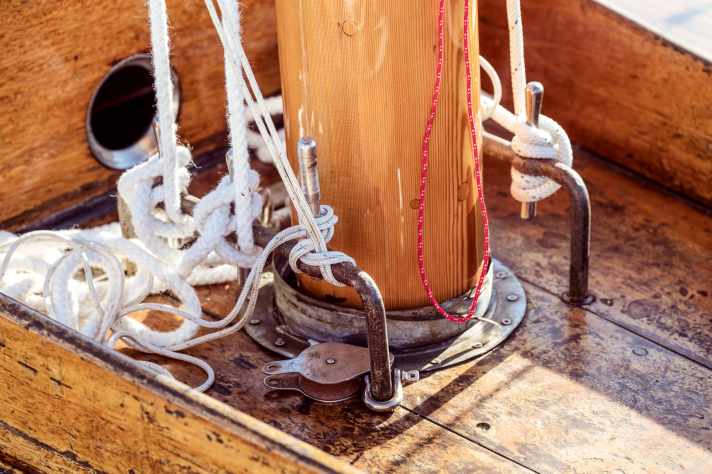
Rebecca Tschöpe also lent a hand herself at some point when she couldn't hold on any longer and really wanted to get out on the water. "So I asked the boat builders at Welkisch whether they would mind if I bought this professional sanding machine and helped out in the cabin at weekends." The Tschöpes were also busy in other ways. A tent was specially made for the restoration work, and they also ordered a new tarpaulin and new cushions for the boat. And Rebecca Tschöpe sewed new curtains for the saloon herself. In June, the time had finally come: "La Liberté" was launched.
And now it was time to get going again. The skerry cruiser was taken out every weekend this year. For the weekend trips, a friend of the family built a mahogany bathing ladder that can be folded up and stowed away easily. Another part of this boat that Rebecca Tschöpe is absolutely delighted with.
Boxes of original equipment were included
She can really live out her passion for old equipment here on board, as all the previous owners have made sure of that. "The Swedes save everything," says Rebecca. "We got boxes of original parts when we bought the boat."
In addition to permanently installed items such as the original pump toilet and the refrigerator from 1934, the first porcelain crockery from "La Liberté" can also be found on board, along with silver cutlery from Robbe & Berking.
Whenever the Tschöpes are looking for something, they check the boxes. Recently, for example, they had to reef and needed a certain crank. One look in the boxes was enough to find the part. Only the old gramophone is no longer on board, but here too the Tschöpe family are not letting themselves get carried away: a new crank record player has already been ordered.
Next year we will be travelling to Sweden
With a fridge, toilet, crockery, cutlery and gramophone, the "La Liberté" is ideally equipped for longer journeys. And that is also the plan. Next year, or the year after at the latest, she will be going on a long voyage. To the home of the "Libban" of course, the Swedish archipelago. And perhaps the last verse of the song about "La Liberté" will ring in the ears of the crew on board as they look out over the archipelago:
"Let's drink to the happy hours we had together. Neither Bacchus nor Venus have let us down. After all, the crew of the 'Liberté' have been the best there is for as long as we can remember."
Text: Luisa Conroy
Technical data "La Liberté"
SK 55 skerry cruiser from 1934
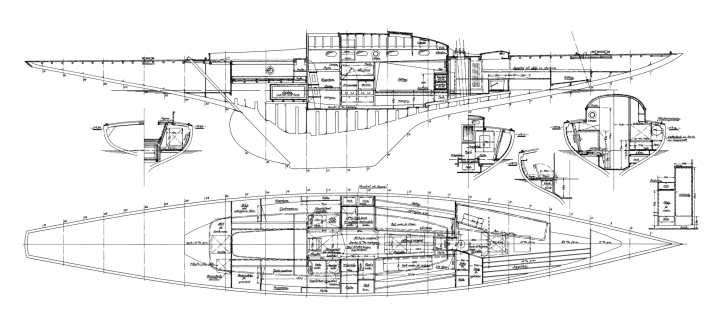
- Design engineer: Erik Salander
- Building yard: Oscar Schelin, Kungsör
- Material:Honduras mahogany
- Total length: 16,30 m
- Width: 2,53 m
- Depth:2,0 m
- Displacement:6,5 t
- sail area: 55 square metres

